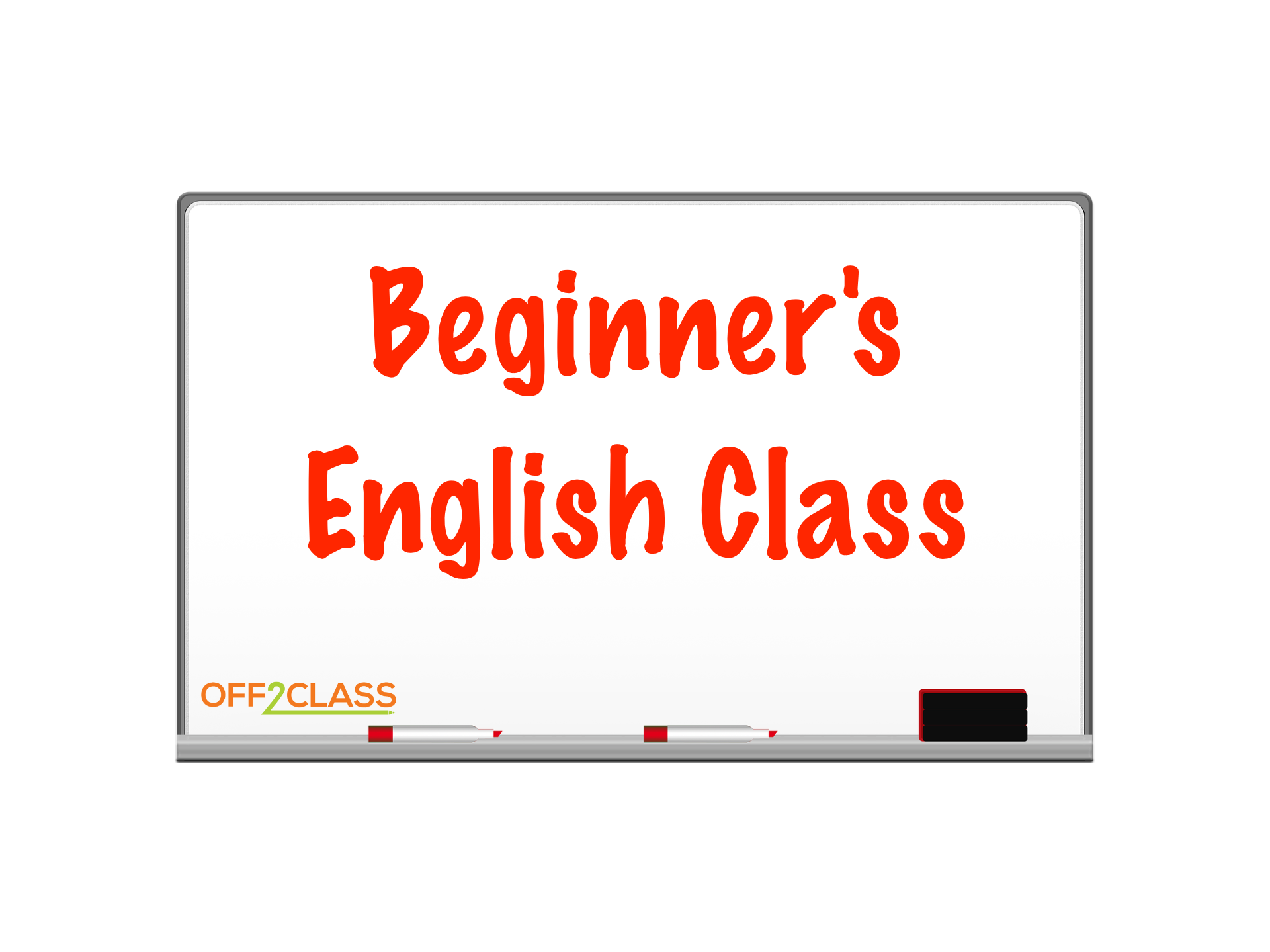10 min read
Share this post

Teaching Beginner ESL — why is it so hard? We’ve been thinking about it a lot lately here at Off2Class as we prepare to release our all-new beginner material. In this community-sourced post, we present what some real teachers had to say!
.
.
.
Why is teaching Beginner ESL so hard? Well, one reason I can think of is that intermediate and advanced learners often know their trouble spots and can tell you about them. A student might say: “I struggle with conditionals,” and so you open a conditionals lesson and off you go. Beginners, however, can be overwhelming — if they need everything, then where do you start? You need basic vocabulary to do basic grammar (and sometimes vice versa), so what’s first? For Off2Class’ first ever teacher-sourced blog post, we messaged thousands of ESL teachers to ask them a very simple question:
.
How do YOU teach beginners?
.
We received hundreds of responses, and we’ve collected some of the replies from teachers all over the world. Keep in mind that these are the opinions of actual teachers. You may agree with some and disagree with others, but these are real techniques that have worked for the teachers who shared them. The responses are in no particular order, so scroll through and see which ones you like. Without further ado:
.
.
Silvia Cristina Wilson , English instructor at Technological University of Panama’s Language Center, Panama City, Panama:
Teaching beginner ESL is not easy! It’s challenging, especially if you never use their native language.
Resources to the rescue! There is a universe of resources online you can use. We almost always start with a game related to the topic from the previous session. We sometimes play hangman, charades, jeopardy®, you name it.
At first, students are afraid because they do not understand much. Eventually they get to be more confident and functional!
.
Santiago Proanon, Academic Coordinator, Fulbright Commission, English Teaching Program, Quito, Ecuador:
In the case of real beginners, I start with the most basic structures and vocabulary in order to build the students’ confidence as early as possible (and not scare them with the new language).
One very important thing; however, is that I would never use, nor encourage the use of L1, even at these beginning moments, as I feel students have to realize that it is possible to communicate in the new language as early as possible.
.
Judith Jimenez, ESL Postsecondary Teacher, Marion County Literacy Council, Ocala, Florida:
I start developing vocabulary. The students that I have taught don’t have any knowledge of English language. I start with the basic, so they can “defend themselves” while they go to do shopping or run errands. That’s the most important part for them.
After this, phrases and then, simple sentences. I do not focus on grammar at this point. I do presentations and conversations in front of the class. (They are afraid and nervous to talk in English.) They need to develop a little conversation because I don’t want them to feel overwhelmed.
.
Sinval Aragao, General English teacher, ELSIS English school, Brisbane, Australia:
My teaching beginner ESL list:
-use pictures for vocabulary
-use Pictionary activities
-use dictogloss
-let them translate to L1, don’t do it yourself
.
Dynnelle Fields, Language Arts Department Co-Chair, Marie Philip School at The Learning Center for the Deaf, Framingham, Ma:
I start with TPR (Total Physical Response). I teach them simple vocabulary (box, drawer, window, door) that is also useful and visible in the classroom, and we practice commands they can follow without having to produce spoken language at first (point to the box, open the window, close the door, show me the drawer etc.). We master a simple verb set that can be used with the nouns I teach them and change them around (open the door, close the drawer, show me the window, etc.). Then we take pictures of them doing these things and caption them. We build vocabulary from there and keep adding on more commands and vocabulary. We make stories and learn about subject and predicate for sentence structure. We build confidence and keep building language as we go.
.
Jenny Olsen, TIC English Language, Wellington High School, Wellington, New Zealand:
One thing I do that seems to work quite well is start the lesson with a speaking activity i.e find someone who, or survey type activity. It gets all the students up and speaking. Then they can write about the survey.
Some students can just do a few sentences, and others I expect to do more. Always seems to work well!
.
Pedro Julião do Nascimento, Private ESL Teacher, Timbo, Brazil:
I pay attention to my own language: I do not use fancy words, idioms, or expressions. However, when I teach parts of the body, I add a few idioms, such as “an arm and a leg”, “the apple of my eye”, etc. I also over-practice pronouns. Most of my students who come from other English courses do not use pronouns, and I don’t like that. Students, especially beginners, should listen to their voices as often as possible in class, so we do pair work and they practice and practice.
.
Dr. Shashikant Kurodi, Assistant Professor of English, SDM College, Ujire, India:
I find texts that suit the mindset and age of the learners. Then, depending on their age, allow them to read for themselves first, then aloud. While reading I ask them to listen to their own voices. Then I help them understand what they’re reading through interaction and a basic writing activity. I correct their mistakes, but I’m careful not to make them feel bad!
.
Holly Jensen, Private ESL Teacher, Clovis, California:
I’m probably going out on a limb here, but when teaching Beginner ESL, I actually let my beginner students use Google Translate. We don’t use it for everything, but it is a good way to fill in the gaps for instructions, and we only use it if we have to. One other thing I do is show and tell. For example, when teaching basic prepositions, I get things from the kitchen. Then I can demonstrate that “The egg is on the plate,” “The fork is beside the plate,” etc.
.
Jennifer Edelson, ESL Teacher , Madison High School, Portland, Oregon:
I start on phonics and simple vocabulary, working on literacy. Then I move on to simple sentences in the present tense. I also include vocabulary that they need to know such as body parts, school, and greetings!
.
Nancy Jo, Owner, Private ESL School, Puerto Rico:
We start with the verb “To Be” and we make the simplest of sentences beginning with “I am….”, and then translate them. I don’t like pantomime, chants or repetitions, nor do most of my learners. We also do (extremely simple) reading activities, and they work well!
.
Jae McLean, Private ESL Teacher, Vietnam:
For absolute beginners, I focus on one letter with its sound per class. I also incorporate nursery songs to switch up the flow. My favorite is the Jolly Phonics 2 song on YouTube. “A is for Apple, a a apple, B is for ball, b b ball” and so on. After every 4 letters, we do a review where I test their memory by drawing pictures (I use Zoom so we can annotate on screen). I try to make sure they can produce at least 4 words to associate with that letter. For instance “Y- yellow, yo-yo, yes, yak”
.
Elaine Gallagher, Ph.D., International Consulting Services, Mexico
I don’t bother to “teach” beginners. Rather, I simply talk with them in English, show videos, sing songs, play games, read them stories, and do artwork. I don’t bother with grammar!
To acquire English, enjoy English, and become fluent in English, grammar is an impediment!
.
Stefania Schindler, Private ESL teacher, Olten, Switzerland:
A first lesson for a real beginner has to start with the most famous (and I agree, it may seem boring for the teacher), “good morning”, “good afternoon”, and so on, and the “what’s your name?” and with short sentences and easy words. Sometimes, I have a lesson where I ask the student to list all the words they think to know in English, and I give them also a list of words I know are “universal” like “taxi”, or “hotel” as it is mostly the same in Latin languages (though it may not work with non-Latin languages).
.
Anupama Cowlagi, Private ESL teacher, Mumbai, India:
When teaching Beginner ESL, I use pictures and play both alphabet and word association games to help increase vocabulary.
For grammar, I use simple examples. I elicit examples from a lot of students after I have explained a particular point in the grammar lesson.
At the beginner level I prefer teaching the following grammar topics:
1) Simple Present, Past and Future
2) Simple Future
3) Present and Past continuous
4) Prepositions – at, in & on
5) How to write simple sentences
6) Conjunctions – And, But, Or, Nor
For grammar topics I use activities like making and transforming sentences, talking about routine, asking and answering questions, and solving riddles.
.
David Michael Vane, Private ESL teacher, Hamilton, New Zealand:
I try to find similarities in their language to English, like in English the game we know as Hangman translates into Russian directly. This game can be translated into many languages and it is games like this which help overcome shyness and promote learning. I think at the outset, shyness is the most important barrier to overcome (with new learners especially)!
.
Adriano Silva, Owner, Private Language School, Brazil:
I start with simple dialogue structures such as greetings, classroom language, and basic communication on trivial subjects such as eating out or shopping, to name a couple.
Once the student feels they have reached a milestone, I gradually introduce some basic grammar, new words, sounds, text reading, etc. that are related to the initial content. This approach is often a sure shot to boost their confidence!
.
Paula Katharina Rylands, Private ESL Teacher, Ubatuba, Brazil:
I start with the verbs To Be, There is, and There Are. It’s important to show the grammar and have students do to a variety of activities, from paper exercices to role-play and drawing maps. I believe this stage is for building awareness rather than precision , and to have the students feel they are learning and can replicate and transfer the knowledge to different situations.
.
.
Wow, THANK YOU to all the teachers that participated. I only wish we had the room to post every response we received!
We have A LOT more to say on the topic of teaching beginners (and on the material to use to teach beginners), but for now, let’s keep this conversation going. Please leave a comment below to answer the same question as the teachers we surveyed:
How do YOU teach Beginners English?
Share this post



13 Comments
It depends on learners’ age. When I begin with kids of 5-6 I use mother tongue, too. I’ve got a lot of short poems where kids first meet English words. It can be one or two new words. Then I play with them with toys,sing songs, watch cartoons, draw pictures. Gradually I introduce them the text- book.
Great point, Natalya, age is an important consideration!
Adult beginners and false beginners are a very special breed of student. Shyness, low self-esteem and embarrassment are their handicaps. What we start with is simple language of introductions, phonics matched with vocabulary to set our pronunciation straight and build on that every lesson.
Whatever the topic we deal with we always personalize it. We write sentences build paragraphs and learn to say these paragraphs in pair work. Surveys work well and so do games as well as videos.
I agree that we need to consider shyness as well as language ability!
I am fond of teaching ZERO English learner probably because I can relate better being a non-native English speaker., and it feels great!
I just had an experience with ZERO English student the other day again, I taught her just to see if she has learned something from the previous lessons she had. I found out there was, but only 2-3 words, the last word she often confused with the other words. Those words were verbs ( drink, eat and swim) which were shown through photos.
I normally would start teaching Pronoun + Verb be verbs after I introduced Verb + ing
When I teach the below vocabulary, I normally act it out, draw , demonstrate using other people or anything , it really depends on how the student responds. I experiment! So here it is,
You are
He is
She is
It is
They are
We are
After this, I would teach the verb+ing so my lessons become
drink – drinking
eat – eating
swim- swimming
Then, time to compose a sentence like below examples ( just to determine if the student can properly identify when to use HE, SHE, IT or THEY.
He is eating
she is drinking
He is swimming
Then, I ask questions answerable by yes or no by showing the student the same photos that by then she is already familiar with like
IS SHE DRINKING?
IS HE EATING?
Then we talk more about her, and I start to introduce other verbs + nouns like
What about you? Are you drinking coffee? Are you drinking tea? milk…etc.its like getting to know in the long run.
My technique is PATTERN! I see that students with zero knowledge of English, not able to read or write ( i mean adult learner) can learn better through patterns. They may not understand the grammar structure but can easily comprehend if they know the technique say for example:
Are you drinking?
Are you drinking coffee?
Are you drinking tea?
Are you drinking milk?
Are you drinking alcohol? (the nouns at the end changes all the time but not the first few words).
Hope it helps you too.
Great perspective, Marie, and I agree on the importance of teaching lexical chunks so that students have phrases they can use in the world even if they don’t understand all of the grammar!
Well to teach young learners I try to explain to them how to learn another language is important. Specially English!!!!them I try to teach them the differences that they can find compared to their mother tongue language.
Gradually I start the vocabulary making them repeat the new words and play with them in some kinds of games .I also talk about cultural things related to the English spoken countries in the world .I use to start grammar very slowly but I think it is nice to compare grammar rules,native -new language.
Thanks for sharing, Elisabeth!
Since I am an EFL teacher and, in my case, I teach Spanish speaking students, the most important thing is that they basically understand the fundamentals of their native language. This is extremely important since they must use their native language as the most powerful tool to learn another language. I give you a small example: In Spanish the verbs do not need a noun or a pronoun to identify the person in question, e.g., ERES. That word is exclusive to the second person singular of the verb SER which in English is the verb TO BE. If I were to write ARE in English I would not know to which person that ARE belongs to. I would have to qualify it with a YOU in this case, and even then, in English, it is unclear if it belongs to the singular or plural. The problem with the Spanish speaking students is that most can not readily identify, in Spanish, to which person a word, a single word, belongs to which person of the given verb in Spanish. Thus, for them, it becomes very difficult to assign its proper value in English. This causes a tremendous amount of confusion to the students unless it is readily addressed and solved by the teacher. So, for beginner students I suggest that the teacher fully understands, and is dexterous as well in, the native language of the student.
Super interesting point of view and a great example, thanks for sharing!
This is a nice exchange of information for all English teachers. I gain insights from all your experiences. My mother tongue is Filipino, I teach Chinese, Vietnamese and other Asians English in the perspective of just English because I cant even understand their own language so I cannot make their grammar as my basis for teaching.
Another thing that helps in the learning is the cultural orientation of the student. It helps to teach beginners when you demonstrate actions but just make sure those gestures are not a taboo for the student.
Thank you so much! I have learned so much.
Glad to hear it, Lorraine!